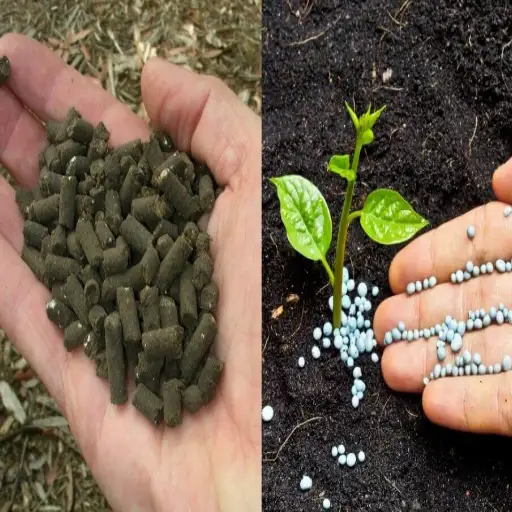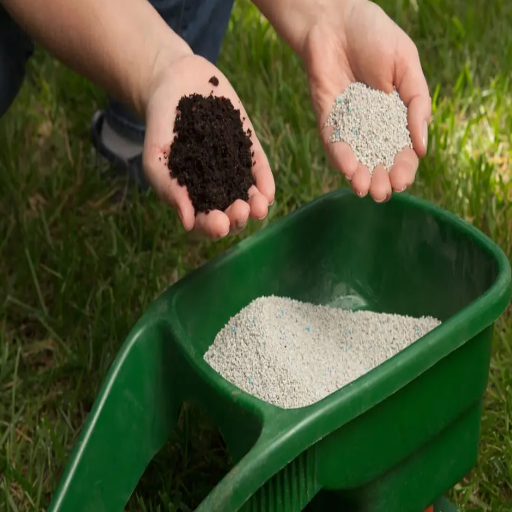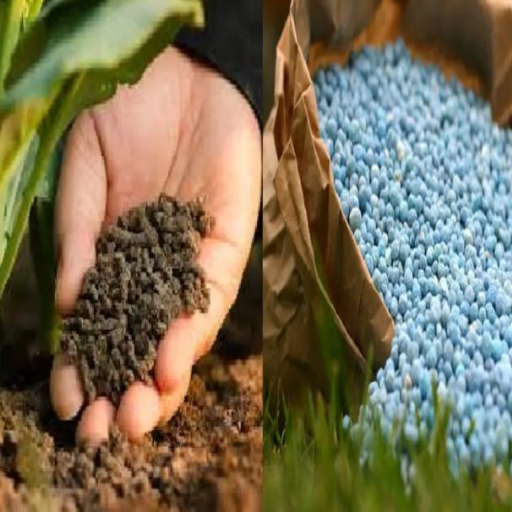Fertilizers play a crucial role in modern agriculture and gardening, directly impacting crop yield, soil health, and environmental sustainability. However, with the wide variety of fertilizers available, choosing between organic and chemical options can be a daunting task. Both types have their advantages and drawbacks, which can influence not only plant performance but also long-term soil fertility and ecological balance. This article dives into the key differences between organic and chemical fertilizers, providing you with a comprehensive understanding of their benefits, limitations, and suitable use cases. Whether you’re a farmer, gardener, or simply interested in sustainable practices, this guide will help you make an informed decision that aligns with your goals and the health of the environment.
The Importance of Fertilizers in Agriculture and Gardening

Why Fertilizers Matter for Plant Growth
Fertilizers are agricultural essentials. They increase plant growth by supplying nutrients that might not always be available in nature in sufficient quantities. These nutrients consist of N, P, and K, which in their glory can be used either in photosynthesis, in the development of roots, or the production of fruits and seeds. This abates any reason to be stunted in growth or reduced yield in a healthy being.
Nitrogen is involved in the building of chlorophyll, which is intensely concerned with photosynthesis, a process during which plants transform sunlight into energy. Phosphorus is essential for energy transfer in plants and is especially important for root and flower formation. Potassium controls the water relations of a plant, counters disease, and builds resistance in general. A number of soils in nature are deficient in these macronutrients, necessitating the application of fertilizers in agriculture and horticulture.
Fertilizers restore the nutrients in the soil to optimize plant productivity and sustain agricultural practices. With no fertilizer made use of, the ability of soil to support huge crop production diminishes over a passage of time. This later leads to reduced agricultural output and food insecurity. When used effectively, fertilizers help to maintain or increase soil nutrient levels, thereby improving soil quality and directly supporting plant growth and the development of a healthy and abundant ecosystem.
The Role of Fertilizers in Soil Health
Fertilizers play a vital role in keeping soil healthy and enriching it by replenishing nutrients depleted by crops over time. The three main nutrients that crops require for growth are nitrogen (N), phosphorus (P), and potassium (K), which become deficient in soils after repeated cropping cycles are carried out. Fertilizer application compensates for these deficiencies, replenishing the nutrient levels so that plants grow tall, strong, and productive with the food they require.
Fertilizers improve soil physique and fertility to some extent, and soil health in general over the long term. For example, organic fertilizers boost microbial activities and slightly improve the soil’s capacity to hold nutrients and moisture, creating the desired medium that supports sustainable agriculture. On the other hand, chemical fertilizers provide nutrients in an almost immediate manner if applied correctly, enabling farmers to fulfill the needs of fast-growing high-yield farming systems that assure food security.
Nevertheless, fertilizers provide only the greatest benefits when rationally applied. They become a big threat when over-applied or misused, as they cause nutrient runoff, acidification of soils, and imbalances of ecosystems. There must be soil testing, precise application, and integrated nutrient management programs to enhance and conserve soil health. Application of fertilizers on the basis of the nutrient status of the soil and needs of the crop, therefore, offers an opportunity to enhance crop production and simultaneously maintain the long-term productivity status of the soil.
Choosing Between Organic and Chemical Options
The choice between organic and chemical fertilization depends largely on the intended purpose, the needs of the crop, and the exigencies of the ecosystem-taking into consideration. Organic fertilizer, being from natural sources of materials such as compost, manure, or bone meal, improves soil health in terms of its organic matter content, microbial activity, and structure on a long-term basis. They are usually slow in nutrient release, thus minimizing leaching and reducing nutrient losses, but they may not meet the immediate nutrient requirements of rapidly growing plants.
Chemical fertilizers, on the other hand, are an acid synthetically manufactured and contain high concentrations of facilitating nitrogen, phosphorus, and potassium (NPK). But precise nutrient composition allows for rapid availability of nutrient,s and therefore becomes necessary when nutrient supplementation must be done immediately. Soil degradation, pollution of water bodies, or damage to beneficial microflora might occur if they are used too often or in excess. Their use should, therefore, be monitored and controlled to reduce the environmental impact.
In most situations, an integrated method combining the application of organic and chemical fertilizers will produce optimal results. On the other hand, organic inputs promote the long-term health of soil, whereas chemical fertilizers counteract short-term nutrient deficiencies. Soil testing and crop nutrient analysis are instrumental for ensuring an adequate balance that maintains productivity and safeguards the environment.
Defining Organic and Chemical Fertilizers

What is Organic Fertilizer?
Organic fertilizers are natural materials that nurture plant growth with essential nutrients, improve the fertility and structure of soil. They basically could be from plant, animal, or mineral origin, such as compost, manure, bone meal, fish emulsions, and rock phosphate. Unlike synthetic fertilizers, organic fertilizers are slow in releasing nutrients, since these materials undergo degradation by soil microbes to available forms. This natural mechanism, in turn, ensures a continuous and balanced supply of nutrients.
One advantage of organic fertilizers is that they improve the long-term health of soil ecosystems. The buildup of organic matter enhances soil aeration, water retention, and microbial diversity. For instance, the application of compost gives long-term benefits by providing macronutrients such as nitrogen (N), phosphorus (P), and potassium (K) that support beneficial microorganisms. These microbes, in turn, assist in root development and nutrient uptake, thus maintaining ecological balance conducive to productive farming and environmental sustainability. In general, organic fertilizers are considered environmentally friendly; yet, their efficiency can vary depending on the nutrient content and mineral availability of the specific product being used.
On the other hand, some organic materials like raw manure and some forms of compost require strict precautions during application to avoid possible contamination by pathogens and salinity to soils. In contemporary agricultural practices, the use of organic fertilizers is combined with modern soil test methodologies to bring soil tests back to optimum nutrient levels. Thereby, this system extends the benefits from organic materials while meeting the nutritional requirements of specific crops and preventing any imbalances in nutrients.
What is Chemical (Synthetic) Fertilizer?
Chemical fertilizers are synthetic substances, formulated and manufactured industrially, intended to provide essential plant nutrients in an apt and precise manner. As such, these fertilizers are mainly inorganic substances because they are manufactured by various chemical methods, like nitrogen fixation via the Haber-Bosch process or producing phosphoric acid for phosphate fertilizers. They generally fall into one major nutrient category, which is nitrogen, phosphorus, and potassium fertilizers or, in short, NPK fertilizers. These nutrients are necessary for life processes: for example, nitrogen is needed for plants to grow leaves and stems, phosphorus helps in developing strong root systems and transferring energy, and potassium helps in improving the overall health of the plant and its resistance against diseases.
With their high nutrient concentration and ease of application, chemical fertilizers came to widespread use in modern agriculture. In contrast to organic fertilizers that start releasing nutrients only as they slowly get into the process of decomposition, chemical fertilizers provide immediate nutrient supply that allows farmers to rectify a deficiency in a short period and thereby help achieve higher yields in shorter crop cycles. Their dissolution into water allows a rather precise control of nutrient application, either by hand broadcasting, foliar feeding, or through fertilization via irrigation systems, thereby optimizing the use of resources in agricultural production. Additionally, synthetic fertilizers are commercially adapted in compound forms to meet the nutrient requirements for a wide array of crops or in exact numbers and forms demanded by a given soil.
On the other hand, higher fertilizer usage is an environmental threat, especially when applied carelessly or in excess. The excess quantity of nitrogen and phosphorus finds its way into water bodies, triggering eutrophication by facilitating the development of algal blooms that cause oxygen depletion, thus disturbing aquatic life and putting drinking water furnaces under stress. While on the way down the environmental ladder, not to mention using up pockets of energy, synthetic fertilizers are also being accused of generating greenhouse gases, especially during nitrogen synthesis. In response to these concerns, scientists are working on precision agriculture techniques and integrating nutrient management systems that combine elements of chemical fertilizer and organic amendment with state-of-the-art soil monitoring tools for a win-win scenario for sustainable and economically affordable farming.
Key Differences Between Organic and Chemical Fertilizers
Because they improve soil for long periods, organic fertilizers are beneficial for soil health and the environment. On the contrary, chemical fertilizers give results in no time but may prove injurious to the soil and environment in the long run.
|
Aspect |
Organic |
Chemical |
|---|---|---|
|
Origin |
Natural |
Synthetic |
|
Release Speed |
Gradual |
Instant |
|
Soil Effect |
Enriches |
Degrades |
|
Eco-Impact |
Positive |
Negative |
|
Expense |
Higher upfront |
Lower upfront |
|
Ease of Use |
Complex |
Simple |
|
Outcome |
Sustainable |
Immediate |
|
Pollution Risk |
Low |
High |
|
Durability |
Long-lasting |
Short-lived |
|
Safety Level |
High |
Moderate |
Advantages and Disadvantages of Organic vs Chemical Fertilizers

Pros and Cons of Organic Fertilizers
Organic fertilizers are those originating from natural materials like compost, manure, or bone meal. These fertilizers come with advantages as well as disadvantages.
Advantages of Organic Fertilizers
- Sustainable Soil Health: Organic fertilizers improve soil structure in terms of water and nutrient retention. This is achieved by providing modifications through organic matter, which stimulates microbial activity and keeps soil fertile in the long term.
- Environmental Safety: These fertilizers minimize incidents of chemical runoff into water sources, thus reducing pollution levels and promoting agri-environmental sustainability.
- Slow Release: One of the different characteristics of organic fertilizers is that nutrients are released slowly into the soil, providing a continuous supply over an extended period to the plants, thus minimizing nutrient leaching.
- Enhances Biodiversity: Organic fertilizers are critical in nurturing a diverse soil ecosystem, including the good fungi and bacteria necessary to maintain soils in good health.
- Safe to Handle: Organic fertilizer categories most commonly pose little or no chemical burn hazard to the applicator or environment.
Disadvantages of Organic Fertilizers
- Lower Nutrient Concentration: Compared to chemical fertilizers, organic fertilizers tend to have low and imprecise nutrient concentrations, making them difficult to adapt to the needs of a given crop.
- Slow Acting: Slow nutrient release does not fit well for crops with immediate nutrient demands and this may retard visible promotion of plant growth.
- Variable Composition: Depending on their sources, organic fertilizers can exhibit great inconsistency in their nutrient content, and thus may require additional testing or supplementation before they can be used to good effect.
- Higher Initial Costs: Although organic fertilizers would offer cheaper rates in the long run, the initial costs are high due to the way they are produced and sourced.
- Difficult to Apply: Organic fertilizers demand a high level of knowledge and meticulous application to achieve uniform spreading and effective results.
Slow in action and more costly, organic fertilizers, however, are probably the best choice for sustaining soil in good health over the long term and for saving the environment.
Pros and Cons of Chemical Fertilizers
Often manufactured from synthetic substances, chemical fertilizers find enormous application in agriculture primarily due to their quick and targeted supply of nutrition to plants. Whereas weighing certain merits, their usage does carry certain disadvantages:
Pros:
- Immediate Nutrient Availability: Chemical fertilizers are manufactured for fast release of nutrients, thereby solving fast nutrient deficiency problems of the plants.
- Specific Fertilizer Composition: Chemical fertilizers can be prepared with any required ratio of nitrogen (N), phosphorus (P), and potassium (K), depending on the crop and soil needs.
- Ease of Use: These fertilizers are produced in granules, liquid, or powder form, which are easily applied with modern farm machinery, requiring much less labor.
- Boost High Yields: If properly used, chemical fertilizers can bring about very high yields, which are necessary to support the mass production of food to feed the growing population.
Cons:
- Environmental Implications: Excess application of chemical fertilizers with runoff leads to aquatic eutrophication and hence disrupts the aquatic ecosystem.
- Soil Degradation: Careless and abysmally repeated use of chemical fertilizers in a given area can alter the pH of that soil and adversely affect beneficial microbes, while also decreasing its organic matter content, which is an important foundation of good soil health.
- Dependency Risks: Heavy dependence on synthetic fertilizers can cause an imbalance of nutrients in soil, thereby making plants dependent on external inputs for their optimum growth.
- Energy Intensive: The process of producing chemical fertilizer typically makes use of fossil fuel, piping greenhouse gas emissions, and raises questions about long-term environmental sustainability.
- Health Risk: At times, chemicals leach down into the drinking water sources or accumulate in the food chain, raising potential health hazards for man and tied.
Organic and chemical fertilizers exhibit special properties that have advantages and disadvantages. To maintain sustainable agriculture, integrated nutrient management practices linking the variables of nutrient sources need to be adopted for long-term soil health, crop productivity, and environmental conservation.
Comparative Nutrient Content
Organic fertilizers provide a vast, slow release of nutrients, whereas chemical fertilizers provide very precise, fast nutrients.
|
Aspect |
Organic |
Chemical |
|---|---|---|
|
Nutrient Type |
Diverse |
Specific |
|
Release Speed |
Gradual |
Immediate |
|
Nutrient Ratio |
Variable |
Fixed |
|
Soil Impact |
Enriches |
Depletes |
|
Longevity |
Long-term |
Short-term |
|
Eco-Impact |
Positive |
Negative |
|
Consistency |
Uneven |
Uniform |
|
Microbes |
Supports |
Reduces |
|
Runoff Risk |
Low |
High |
|
Cost |
Higher upfront |
Lower upfront |
Environmental Impact of Fertilizers

Runoff and Pollution from Chemical Fertilizers
The use of chemical fertilizers in agriculture leads to serious environmental concerns, especially runoff and water pollution. When applied, these fertilizers are often in excess, unabsorbed by plants, and leach into adjacent water bodies. Runoff is accelerated by rainfall or irrigation, creating a high concentration of nitrates and phosphates in rivers, lakes, and coastal waters. This leads to eutrophication, in which nutrient-loaded waters give rise to algal blooms that then deplete oxygen levels and cause severe detriment to aquatic ecosystems.
From my point of view, the problem is exacerbated since chemical fertilizers do not foster healthy microbial activity as their organic counterparts do. The lack of support for soil biodiversity, paired with the continuous nutrient runoff, further drains the soil’s natural ability to effectively retain nutrients. The result is a corporative dependency on repeated applications of chemicals to maintain crop yields and, consequently, a situation that only aggravates environmental toxicity over time.
In my consideration, the societal and ecological price of chemical fertilizers seems to far outstrip their apparent economic benefits. Contaminated groundwater nitrates pose direct risks to human health, causing methemoglobinemia or blue baby syndrome. In addition, the impacts are felt by marine life in general, fisheries, and recreation ecosystems, thereby underlining the pressing policy interest toward a better fertilizer application approach. By considering such balanced and environmentally sound alternatives, the detrimental impacts from chemical runoff can be curbed while ensuring that agricultural needs remain adequately met.
Climate Change and Synthetic Fertilizers
Synthetic fertilizers constitute an important source of greenhouse gas emissions, especially through the release of nitrous oxide (N₂O), a potent greenhouse gas with a global warming potential of about 300 times that of carbon dioxide (CO₂). While nitrous oxide emissions primarily emerge due to excess use of nitrogen-based fertilizers—excess beyond what crops can absorb—other chemical processes such as nitrification and denitrification operate in soil ecosystems.
In addition, their manufacture consumes too much energy, and this energy comes from fossil fuel sources. The Haber-Bosch process for the synthesis of ammonia, the principal raw material for nitrogen fertilizers, is therefore a large consumer of energy and a major emitter of carbon. With this carbonization of agriculture, one would find that the direct manufacture of ammonia consumes some 1-2% of the world’s energy supply and is accompanied by great amounts of CO₂ emissions.
To curb these emissions, a multi-pronged strategy is required, including precision agriculture for fertilizer applications, utilization of nitrification inhibitors, and production of green ammonia via renewable energy sources. Proper implementation of these measures can reduce the synthetic fertilizer’s impact on the environment while catering for enough food for the world’s ever-growing demands.
Eco-Friendliness of Organic Options
The eco-friendliness of organic agricultural practices primarily stems from lower dependence on synthetic inputs and an emphasis on enduring soil health. Organic farming never permits the use of synthetic fertilizers and pesticides that cause soil degradation, contamination of water, and carbon emissions at significant levels. Natural options are used instead: compost, manure, cover crops, etc.-all of which enrich the soil, maintain a closed nutrient cycle, and minimize nutrient leakage into the environment.
Recent studies allow us to appreciate the role that organic systems could play in enhancing soil carbon sequestration, a key process in climate change abatement. Organic soils increased the organic matter content and microbial activity, thus fostering an ecosystem that is resilient and has biodiversity. Other interventions include integrated pest management in organic farming systems to reduce chemical intervention and, thereby, reduce harmful residues in the environment.
Still, efficacy is at the heart of the analysis concerning organic farming’s overall environmental achievements. The application of organic agriculture is less efficient than traditional farming practices per yield area, leading to numerous arguments concerning land-use implications and scaling up operations. At present, few innovations are likely to further improve the sustainability status of the organic system while providing some resolve on productivity issues such as biofertilizers and improved crop rotation models.
Cost-Effectiveness of Organic and Chemical Fertilizers

Initial Costs of Organic vs Chemical Fertilizers
Organic fertilizers have a higher initial cost but offer greater long-term benefits; chemical fertilizers, on the other hand, are cheaper initially but may bring costs in the future.
|
Aspect |
Organic |
Chemical |
|---|---|---|
|
Upfront Cost |
Higher |
Lower |
|
Long-Term Cost |
Lower |
Higher |
|
Application |
Labor-intensive |
Easy |
|
Sustainability |
High |
Low |
|
Reapplication |
Less frequent |
Frequent |
|
Eco-Impact |
Positive |
Negative |
|
Soil Health |
Improves |
Depletes |
|
Market Price |
Premium |
Affordable |
|
Value |
Long-term |
Short-term |
|
Risk |
Minimal |
High runoff |
Availability for Different Scales of Gardening and Farming
The availability of organic and chemical farming solutions differs considerably, depending on the scale of the operation, because of differences in logistics, cost structure, and practical implementation methods. For example, in small-scale gardening, compost, manure, and bio-fertilizers are organic remedies that growers can easily get and apply. Manure may come from a local source or even from one’s backyard, such methods being more in line with sustainability goals and requiring very little external input.
Trending influences render chemical remedies available from retail markets, easier to apply, and therefore indispensable for medium-scale-type applications. Admittedly, being re-applied on a very frequent basis, costs can go up over time, while the threats to environmental sustainability increase in the same instance.
On a big scale of agriculture, chemical fertilizers and pesticides rule: with efficiency required greatly, and yields are very high. Such solutions are distributed through specialized suppliers with strong supporting infrastructure for meeting the demands of large farming operations. Organic inputs on this scale require heavy investment in supply chains and arrivals; however, technologies like mechanized composting plants or advanced biostimulants are trying to address this gap.
With growing concern about sustainability worldwide, increased funding and research are being dedicated to developing the scalability of organic farming, all of which speaks to a big promise of wider adoption at all levels.
References
Frequently Asked Questions (FAQ)
Q: What are organic fertilizers made from?
A: Organic fertilizers are made from natural materials such as animal waste, compost, and other decomposing materials. These fertilizers nourish the soil by adding organic matter that promotes microbial activity, enhancing soil health.
Q: What are the disadvantages of using chemical fertilizers?
A: The disadvantages of using chemical fertilizers include their potential to disrupt the natural balance of soil microorganisms, leading to long-term chemical buildup. They can also contribute to waterway pollution and cause issues like algae blooms due to runoff.
Q: How do organic fertilizers nourish the soil differently than chemical ones?
A: Organic fertilizers nourish the soil by improving its structure, enhancing its ability to hold moisture and nutrients, and increasing microbial activity. In contrast, chemical fertilizers provide nutrients in a readily available form but may not improve soil health over time.
Q: Are organic fertilizers more expensive than synthetic ones?
A: Organic fertilizers tend to be more expensive than synthetic ones due to the cost of sourcing natural materials and the manufacturing process involved. However, they offer long-term benefits for soil health and crop growth that may offset the initial investment.
Q: What factors should be considered when choosing the right fertilizer?
A: When choosing the right fertilizer, consider factors such as the nutrient needs of your plants, the condition of your soil, environmental impact, and whether you prefer organic or chemical solutions. It’s important to weigh the pros and cons of both types of fertilizers.
Q: Can using organic fertilizer prevent insect infestations?
A: Using organic fertilizers can help build healthier plants that are more resilient to insect infestations. Healthy soil promotes robust plant growth, reducing the need for chemical insecticides and enhancing the overall ecosystem.
Q: What are the potential drawbacks of using organic fertilizers?
A: Some potential drawbacks of using organic fertilizers include slower nutrient release compared to chemical fertilizers and the need for larger quantities to achieve the same nutrient levels. Additionally, they may require more frequent applications.
Q: How do organic and synthetic fertilizers affect crop growth?
A: Organic fertilizers improve soil health over time, which can lead to sustainable crop growth, whereas synthetic fertilizers provide immediate nutrients that can boost crop yields in the short term. However, reliance on chemical fertilizers may lead to soil degradation in the long run.
Q: What is the environmental impact of using chemical fertilizers?
A: The environmental impact of using chemical fertilizers includes water pollution from runoff, which can lead to problems such as algal blooms and harm aquatic ecosystems. In contrast, organic fertilizers are generally considered more environmentally friendly as they improve soil health without harmful side effects.







